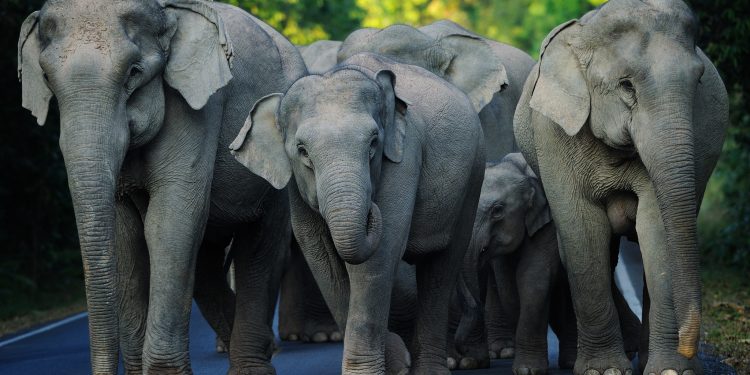By Anisha Khatun, OP
Majestic and mysterious, elephants have long captured the human imagination—towering symbols of wisdom, memory, and grace. In the cultural tapestries of India and beyond, they are venerated as sacred beings, protectors of forests, and embodiments of divine strength. Yet their significance stretches far beyond myth and metaphor. Elephants are the silent architects of the wild—“gardeners of the earth”—whose every step nurtures the natural world. As they roam ancient pathways, they clear forests, spread seeds, and create vital waterholes, quietly shaping the ecosystems that sustain life itself.
But today, their trumpets are fading into silence. Shrinking habitats, illegal poaching, and human encroachment have cast a dark shadow over their future. The Asian elephant, once a proud sentinel of the subcontinent’s jungles, now walks a perilous line between survival and oblivion.
To save the elephant is to preserve the soul of the wild. It is to defend a lineage that predates us by millennia and to honour a creature whose very existence nourishes the earth. As the forests whisper their age-old secrets, may we listen— and act.
Also Read: Odisha govt rejects proposal for online sale of Puri Jagannath temple’s ‘Mahaprasad’
Ahead of World Elephant Day, here’s what the experts have to say on the issue.
Rebuilding bonds
While not many of us are much concerned about these engineers of ecosystems, ‘Hati Sabha,’ a unique initiative, emerges as a beacon of hope. Organised across 10 districts of Odisha, this grassroots initiative fosters dialogue between communities and conservationists—between the people and the elephants who have shared the land for centuries. Through storytelling, shared memories, and indigenous wisdom, these gatherings seek to revive old bonds and build new pathways for coexistence.

‘Hati Sabha’, an initiative under Bikash Saathi — a non-profit organisation founded by Wildlife Biologist Dr. Biswajeet Panda — is being organised in collaboration with Orissa POST and Dharitri. Working at the intersection of conservation and community empowerment, the initiative brings together the power of journalism, local engagement, and environmental action. By reawakening empathy, deepening local understanding, and integrating traditional knowledge into modern conservation practices, Hati Sabha reminds us that the answers to coexistence may already lie within the hearts of those who have long lived in harmony with the wild.

Panda describes Hati Sabha as a grassroots platform dedicated to fostering peaceful coexistence between humans and elephants. The initiative engages local communities through dialogue, awareness, and participatory planning, with the goal of building an elephant-friendly environment rooted in understanding and mutual respect.
According to him, the primary objective of Hati Sabha is to gather public perception, promote awareness, and encourage behavioural change by deepening the understanding of elephant movement and ecology. “By involving the community directly, we are not just protecting elephants—we are creating a shared sense of responsibility,” he says.
Panda emphasises the urgent need to connect the younger generation to the cause of elephant conservation. “Raising awareness among the younger generation is crucial because they are the future custodians of our natural heritage. Elephants, often referred to as the keystone species, play an irreplaceable role in maintaining forest ecosystems. They are the natural gardeners of the wild, helping in forest regeneration by dispersing seeds and clearing pathways that benefit other species.”
He believes cultivating empathy among youth today is essential to shaping a more sustainable tomorrow. “As musketeers of natural resources, it is our collective duty to ensure that the younger generation understands the ecological, cultural, and environmental significance of these majestic creatures. Their active involvement and empathy today can shape a more sustainable and harmonious future for both humans and wildlife.”
However, the challenges remain daunting. “Elephants today face numerous threats that endanger their survival. Illegal poaching for tusks continues to be a major issue, driven by the ivory trade. Additionally, electrocution from power lines, intentional poisoning, and railway collisions have led to significant mortality,” he explains. Rapid infrastructure development has fragmented their corridors, severely affecting natural movement. “Emerging concerns like plastic pollution are also affecting elephants, with traces of plastic and harmful components now being found in their dung.”
As for individual action, Panda advocates simple but impactful changes. “We must adopt the principle of ‘Respect and Protect.’ It is essential not to disturb elephants in their natural habitat. Avoid using firecrackers or fireball devices, which cause panic and injury. Promoting the restoration and growth of bamboo forests and native vegetation supports their food needs and movement. Most importantly, raising awareness among local communities is vital for long-term conservation.”
‘By protecting elephants, we protect ourselves’
Sangita Iyer, an Indian-born Canadian author, award-winning broadcast journalist, wildlife biologist, and documentary filmmaker, is widely recognised for her tireless advocacy for elephant conservation. Known for exposing the cruelty faced by Asian elephants, she has become a global voice for wildlife protection. Drawing attention to the significance of elephant conservation, she passionately explains why it’s crucial for the younger generation to understand their role in safeguarding nature.

“Elephants are a keystone species,” says Iyer. “The survival of many wild animals in forest ecosystems—and indeed our own survival—depends on them.” She explains that elephants roam for 16 to 18 hours a day, dispersing nearly 200 kilograms of dung daily. This dung is filled with seeds, as elephants digest only about 40% of what they eat. “These seeds are whole and nutritious, and as elephants wander, they naturally plant trees across vast landscapes. Those trees provide oxygen and absorb carbon dioxide, a major greenhouse gas,” she adds. “In this way, elephants are climate mitigators. If we protect elephants, we protect ourselves. If we harm them, we ultimately harm ourselves.”
She also sheds light on the major threats elephants face today across Asia and Africa. “Poaching remains a severe problem,” she warns. “Illegal wildlife criminals kill elephants for their tusks, which are sold to fund the purchase of ammunition used in terrorist activities. Wildlife crime is not just an environmental concern—it’s a national security threat.”
In Odisha, she points out that electrocution has become a leading cause of elephant deaths. “Power companies must take responsibility. Their negligence allows poachers to easily access live wires and use them as deadly traps. These companies need to upgrade their technology and prioritise safety,” she says.
Elaborating on the role of elephants in maintaining the balance of forest and grassland ecosystems, Iyer says, “Elephants pull down tree canopies, allowing sunlight and rain to nourish the forest floor. This encourages the growth of hardwood trees, which store more carbon than softwood trees. Elephants also fertilise the soil and improve forest density—making them critical to combating climate change.”
She lays stress on the importance of education and awareness. “Educate yourself through short films and credible resources. If you witness harassment of elephants, report it. Treat elephants with compassion and respect. Organise or participate in school art contests, essays, and awareness drives. Teachers must take children into nature to help them form real connections. The more people understand that elephants are essential to our survival, the better our chances of protecting them.”
‘Climate change is disrupting wildlife lifestyles’
Sanjukta Basa, former honorary Wildlife Warden of Mayurbhanj, underscores the crucial role of youth in shaping the future of conservation. With climate change affecting both human and animal behaviour, she believes the younger generation must be empowered to lead environmental efforts. “The role of youth groups in building a healthy society is extremely crucial,” she says. “Climate change is not only altering human behaviour but also disrupting wildlife patterns and lifestyles. These shifts pose serious threats to society, and it is the youth who will inherit and have to address these challenges. Their enthusiasm and drive to create positive change can be channelled into impactful conservation work.”

Reflecting on the current threats to elephants, particularly in Odisha, Basa offers a grounded perspective on the escalating human-elephant conflict. “For nearly a decade, Odisha has witnessed frequent elephant attacks and rising conflict. But it’s unfair to place the blame solely on the animals,” she says. “The truth is that rapid deforestation and habitat encroachment—through mining, agriculture, and development—have fragmented their natural spaces. Elephants are being forced to venture into villages in search of food and shelter. In the process, they damage crops, destroy homes, and sometimes, tragically, cause human casualties.” Despite these challenges, Basa insists on recognising elephants as allies in forest conservation. “Elephants play a vital role in maintaining the health of forests and grasslands,” she says. “They create pathways by breaking branches and uprooting trees, allowing sunlight to reach the forest floor and helping smaller animals navigate dense vegetation. These gaps promote biodiversity and healthy forest growth.” Moreover, elephants act as natural seed dispersers—consuming fruits and depositing seeds, often with nutrient-rich dung, thus supporting regeneration. “They are the silent architects of the wild, shaping ecosystems in ways no other species can.”
On the role individuals can play, Basa advocates for proactive, grassroots engagement. “We each have a role to play in elephant conservation,” she says. “Raising awareness about their ecological and cultural importance is key. Educating communities about the consequences of poaching, legal frameworks, and available compensation mechanisms can build empathy and support. Collaborating with locals to resolve conflict and integrating conservation into educational and community programs will ensure that future generations grow up as protectors, not adversaries, of the wild.”







































